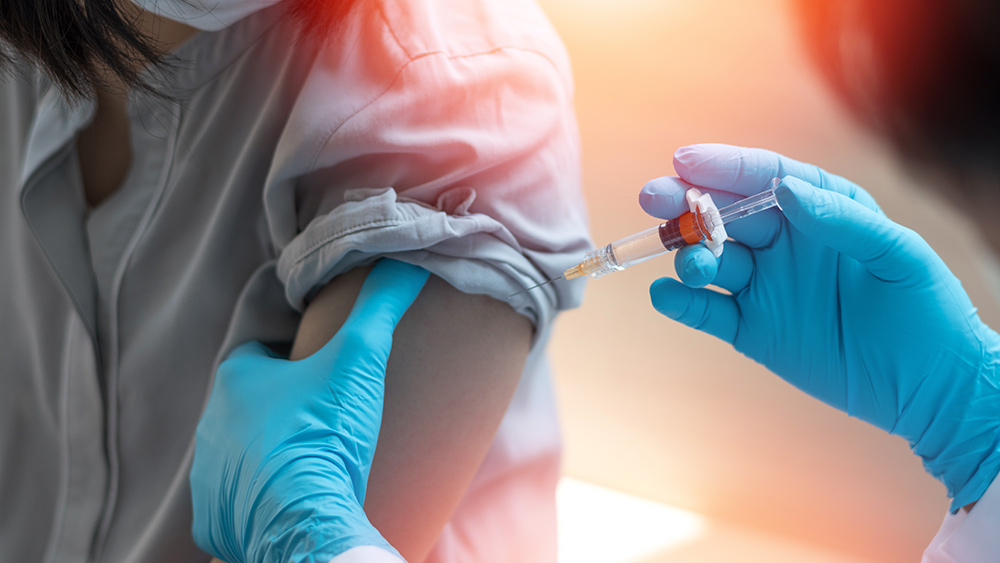Swiss health insurance report: People receiving cancer treatment since 2020 skyrocketed by 73% after rollout of COVID vaccines
01/02/2024 / By Belle Carter

A major health insurance company in Switzerland previously reported that since 2016 the number of patients receiving cancer treatments has decreased. However, in 2021, the Helsana Drug Report, which has been published annually for the past 10 years, reflected a dramatic increase of 73 percent in the number of patients receiving cancer treatments compared to the previous year. Moreover, the high cancer cases report continued in 2022 with an increase of 74 percent compared to 2020. It is important to note that the Wuhan coronavirus (COVID-19) mass vaccination campaign began on Dec 23, 2020.
The said report was highlighted by Konstantin Beck, a health economist at the University of Lucerne, in a video (in German without the option of subtitles) earlier this month. Transition News has published an article on the video, which is also in German but can be translated using an online tool. As per the video, a health survey conducted by the Swiss Federal Statistical Office (BfS) was published on Nov. 3 and found that in 2022, 85 percent of the Swiss population aged 15 and over felt healthy and 83 percent felt happy. “At the same time, more than a third live with a permanent health problem. Psychological stress has increased compared to 2017. The 15 to 24-year-old age group is particularly affected, especially young women,” Beck said.
Based on the study, the Swiss population was healthier in 2022 than five years earlier. However, the statistics office’s statement didn’t match the detailed data collected from the health survey and published by BfS. Data was unpublished a few days later but before it was removed, the detailed survey data showed that in 2017, 33,339 people stated that they had had a heart attack, 27,584 a stroke and 116,603 had cancer. Meanwhile, in 2022, there were 170,000 cases of heart attack, 124,515 cases of stroke and 460,771 cases of cancer.
Beck explained that the data collected from the 2017 survey was not comparable to data from the 2023 survey. Back in 2017, BfS’ survey asked: “Did you have any of the following illnesses or health problems in the last year?” Heart attacks, strokes and cancer were listed as the options. But this year, the survey question was: “Have you ever had any of the following illnesses and health problems in your life?” With a huge difference, the numbers from 2022 understandably were massively higher, Beck pointed out. However, what is not understandable is why the question was changed and thereby torpedoed comparability.
“The authorities must know that this is a very sensitive question because these numbers could reflect the negative effects of the COVID-19 injections. And if BfS first publishes such data and then deletes it again, it doesn’t make a good impression. What is striking is that BfS did not mention that there was an increase in heart attacks, strokes and cancer,” Beck noted. Cancer cases doubled. In 2020, the number of people receiving cancer treatments was nine percent higher than the trend line. In 2021 it was 95 percent higher and in 2022, 106 percent higher than expected. (Related: Dr. Robert Malone warns Moderna’s COVID-19 vaccine may cause CANCER.)
The Helsana report analyzes the Swiss pharmaceutical market and provides insights into the cost and consumption of drugs. It is prepared in cooperation with the University Hospital Basel and the Institute of Pharmaceutical Medicine of the University of Basel. The latest report, published on 30 November 2023, shows data for the year 2022.
Study: Different vaccines cause different system metabolic changes
The type of COVID-19 vaccine and the time interval between vaccination and PET/CT scans are key factors in minimizing false interpretations in cancer patients, according to research published Dec. 9 in Scientific Reports.
According to first author Tina Nazerani-Zemann of the Medical University of Graz in Austria and her colleagues, the study is the first to examine systemic response changes in patients in correlation to time after COVID-19 vaccination using three different vaccines. “Different vaccines cause different system metabolic changes. The knowledge of vaccine type, the time interval between vaccination and PET/CT scan is essential, especially in therapy evaluation,” the group noted. “As the vaccination program continues, we encountered increased F-18 FDG-activity not only in axillary lymph nodes ipsilateral to the injection site but also in other organs,” the authors added. F-18 FDG is a positron-emitting radiotracer used with positron emission tomography (PET) to diagnose and monitor various conditions.
The group collected data on 220 eligible vaccinated cancer patients (127 with Pfizer-BioNTech, 61 with Moderna and 32 with AstraZeneca) who underwent F-18 FDG-PET/CT scans. Of these, 71 patients also underwent a pre-vaccination scan. Most of the patients did not receive any therapy related to their diagnosis at the time of the scan. The researchers evaluated the exams from day 1 to day 135 after different vaccinations and found a steady decrease in all patients after Pfizer-BioNTech vaccinations. Ten days after vaccination, the FDG uptake was at its highest activity, and 70 days after vaccination, the FDG activity was not different from the background activity of the tracer in the axillary region, the researchers reported and added that the result also applies to the other two vaccines.
Ultimately, numerous studies suggest increased activity in local sites and ipsilateral axillary lymph nodes in F-18 FDG PET/CT scans after COVID-19 vaccination, yet correctly interpreting these changes remains a challenge, the authors noted. “Our study underscores the significance of changes in 2-[F-18] FDG PET/CT scans in lymph nodes and reference organs after vaccination and highlights the importance of this information in the interpretation of PET/CT in vaccinated patients,” the group concluded.
Read more news on the adverse health effects of COVID-19 vaccines on VaccineDamage.news.
Sources for this article include:
Submit a correction >>
Tagged Under:
Big Pharma, cancer treatment, conspiracy, covid-19, deception, health insurance, Helsana Drug Report, Konstantin Beck, pandemic, pharmaceutical fraud, real investigations, switzerland, vaccine damage, vaccine injury, vaccine wars, vaccines
This article may contain statements that reflect the opinion of the author
RECENT NEWS & ARTICLES
COPYRIGHT © 2017 BIG PHARMA NEWS


















